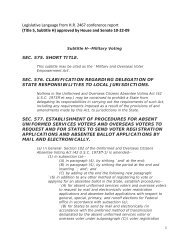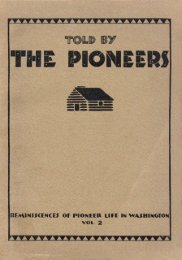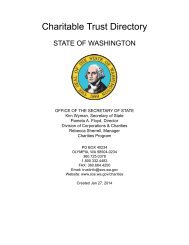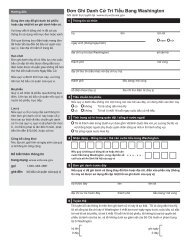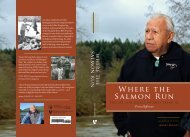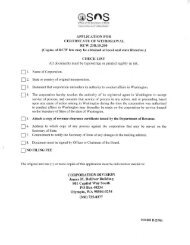booth gardner - Washington Secretary of State
booth gardner - Washington Secretary of State
booth gardner - Washington Secretary of State
You also want an ePaper? Increase the reach of your titles
YUMPU automatically turns print PDFs into web optimized ePapers that Google loves.
The French-Canadians who came to the meeting at the Champoeg warehouse on<br />
May 2, 1843, knew they were being rapidly outnumbered but stood their ground. The<br />
proposal to form a provisional government and authorize a militia was rejected on a voice<br />
vote. The Americans protested that many were confused over what acceptance <strong>of</strong> the report<br />
would mean. The secretary called for a division <strong>of</strong> the house, a parliamentary procedure<br />
requiring factions to physically divide into groups. It was then that a larger-than-life character<br />
– Joseph Lafayette Meek – plopped himself in the middle <strong>of</strong> Northwest history. At 6-2 and a<br />
lithe 200 pounds, Meek cut an intrepid figure in his beard, buckskins and white vest. Leaving<br />
Virginia as a teenager, he became a Rocky Mountain fur trapper. Meek engaged in hand-topaw<br />
combat with more than one big bear and had mixed relations with the Indians, literally<br />
and figuratively. He married the daughter <strong>of</strong> a Nez Perce chief and had several mixed-race<br />
children whom he loved dearly, fuming when they were ostracized. Tales <strong>of</strong> his exploits sound<br />
too good to be true. Happily, most <strong>of</strong> them are.<br />
At Champoeg that fateful day, Meek bellowed,<br />
“Who’s for a divide? All for the report <strong>of</strong> the committee<br />
and an organization follow me!” Robert Moore strode to<br />
his side, together with Medorem Crawford. When they<br />
counted noses, the Americans had narrowly prevailed.<br />
Meek reportedly waved his hat and gave a shout, “Three<br />
cheers for our side!” The Americans roared. Meek, Moore<br />
and Crawford went on to serve in the Oregon Legislature.<br />
Often romanticized, the events at Champoeg hold<br />
their own in objective accounts. They “symbolize the<br />
entire movement to establish a provisional government”<br />
for what was to become the Oregon Territory, historian<br />
John A. Hussey concludes. Champoeg <strong>State</strong> Park near<br />
Newberg, a lovely diversion midway between Portland<br />
and Salem, is one <strong>of</strong> the Northwest’s most important<br />
historic sites. As the breeze rustles in the trees along the<br />
ridge above the river, you get the feeling you’re not alone.<br />
(Champoeg is, and was, pronounced chuhm-POIeek by<br />
Native Americans. The settlers said cham-POH-eg, while the common pronunciation today<br />
is sham-POO-ee.)<br />
* * *<br />
“Uncle Joe” Meek, 33 years old, was chosen sheriff. A nine-member legislative<br />
committee was elected to draft a code <strong>of</strong> laws until the sovereignty questions could be<br />
resolved. The committee lacked a lawyer, but Booth Gardner’s great-great-great grandfather<br />
served ably as its chairman. Robert Moore had acquired some 1,000 acres on the west side<br />
<strong>of</strong> Willamette Falls, opposite Oregon City. Most settlers simply took whatever land they<br />
Joe Meek when he was Oregon’s U.S.<br />
Marshall. Oregon Historical Society photo.<br />
184



